The addition of zinc in the hot-dip galvanizing process serves as a protective barrier against harsh environments and impurities. Learn more about galvanized steel coil and its benefits.
What is Galvanized Steel Coil?
Galvanized steel coil is a type of steel coil that has been coated with a layer of zinc to protect it from rust and corrosion. The process of galvanization involves immersing the steel coil in a bath of molten zinc, which creates a metallurgical bond between the zinc and the steel. It results in rust and corrosion resistance.
Galvanized steel coil is commonly used in a variety of industrial applications, such as the construction of buildings, bridges, and other infrastructure projects, as well as in the manufacturing of automotive parts, electrical equipment, and household appliances. It is also frequently used in the production of metal roofing and siding for residential and commercial buildings.
Galvanized steel is typically made from low-carbon steel, which is a type of steel that contains less than 0.2% carbon. This type of steel is used because it is easy to work with and has good welding and forming properties.
Steels Grade of Galvanized Steel Coil
Commercial Steel (CS)
This steel consists of carbon with a level range of 0.04 percent to 0.10 percent and manganese with a level range of 0.2 to 0.6 percent. CS has a cold-rolled substrate with a fifty- to eighty-percent reduction before it undergoes galvanizing line processing. Commercial steel has three types of chemical compositions, such as CS Type A, CS Type B, and CS Type C.
Forming Steel (FS)
This steel has about 0.25 percent manganese and 0.04 to 0.06 percent carbon. FS is not as hard compared to CS due to its 60 to 80 percent cold reduction during processing, which makes it formable during application.
Structural Steel (SS)
SS has a carbon level range of 0.04 to 0.20 percent and a manganese level range of 0.4 to 1.6 percent. The steel sheet undergoes cold rolling for a fifty- to seventy-percent reduction. Structural steel has a yield strength of 33–80 ksi and passes the standard requirements for mechanical properties.
Hot-Dip Galvanized Steel Coil Process
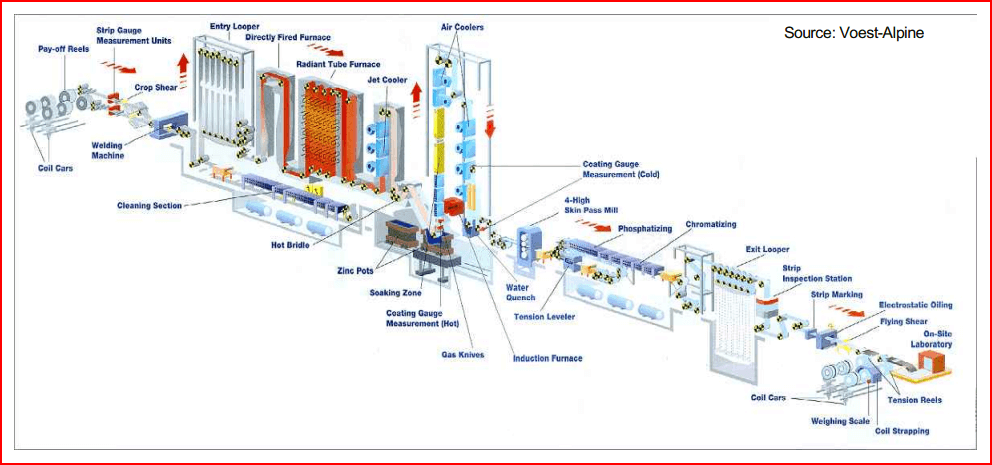
Hot-dip galvanized steel coil undergoes several steps. It passes a continuing process by using an entry-end welder to connect the coil’s end to the next coil. Dirt, oils, and surface contaminants on the sheet surface are eliminated in an alkaline cleaning section.
The steel passes through a heating process in an annealing furnace at the highest temperatures to apply the desired mechanical properties, such as formability and strength. The steel sheet undergoes a molten zinc bath at a certain coating level, depending on the application.
An application of gas knives takes place to clean up excess metal coating and reach the desired coating weight. The steel sheet goes to a cooling section to cool off and allow the coating to solidify after being removed from the bath. It passes through a temper mill to obtain the steel’s desired finish on its surface before flattening it using a tension leveler.
After meeting the end-user requirements, the steel sheet passes through a treatment section to protect it from storage stains on its coating surface. A forming oil is applied in the oiling section to prevent the sheet from rusting before it goes to a recoiler for rewinding.
resource: https://www.galvinfo.com/wp-content/uploads/sites/8/2017/05/GalvInfoNote_2_1.pdf
Useful Galvanized coil Metrics
Theoretical Weight (Mass) per Unit Area
Hot-dip galvanized steel coil has a lower density compared to steel. Compared to an uncoated steel with the same thickness, hot-dip galvanized steel has a lesser weight per unit area. The theoretical weight per unit area is essential when manufacturing large volumes of coated steel.
The coating type, coating thickness, and steel substrate influence the weight adjustment in zinc alloys. The coating factor (CF) represents the weight (mass) adjustment per unit area. It is the weight difference between the steel of the same thickness and the coating metal. To calculate the theoretical weight per unit area of the coated sheet, you have to subtract the CF from the weight of the uncoated steel sheet with the same thickness.
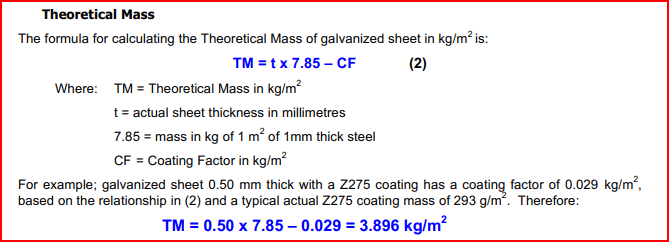
resource: https://www.galvinfo.com/wp-content/uploads/sites/8/2017/05/GalvInfoNote_1_10.pdf
What Portion of a Galvanized Coil is Zinc?
A standard galvanized coil has about 99.7 percent zinc coating. But it all depends on the steel sheet’s coil thickness. For example, a steel coil with 0.012″ thick G90 sheet has 12.5% zinc, while 0.050″ thick G90 has 3 percent zinc.
Thinner gauges contain a higher zinc content. The cost of zinc impacts the thickness of zinc coatings on galvanized sheets. The galvanizing thicknesses are represented by G numbers. For example, G60 has a zinc coating of 0.60 oz/ft2 on both sides. The zinc coating for each side is 0.5 mil (1 mil is equivalent to 0.001 inch).
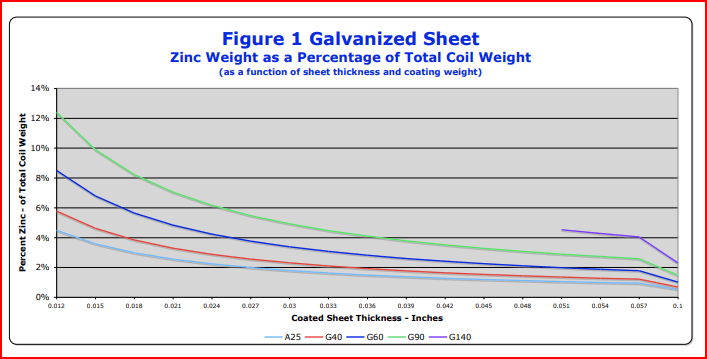
resource: https://www.galvinfo.com/wp-content/uploads/sites/8/2017/05/GalvInfoNote_1_10.pdf
Selecting Coating Thickness (Weight or Mass) for Galvanized Steel Coil
Effect of Atmospheric Conditions
Atmospheric conditions impact the corrosion rate of galvanized steel coils. Different regions of the world have different influences on their outdoor applications, like the southwestern part of the United States. This region experiences long, foggy seasons and high annual rainfall that contribute to corrosion.
Other factors affecting the corrosion rate include pollutants and impurities in the air, such as acid, nitrates, chlorides, sulfates, and smoke emissions. The oxygen content of the electrolyte, extreme temperatures, moisture, and humidity all contribute to the product life of galvanized steel coils.
Product Life Considerations
The coating weight (mass) in hot-dip galvanized steel depends on its performance requirements in the desired application. Outdoor applications like a metal building roof require a thicker zinc coating to prevent red rust formation.
Over the years, the roof has slowly started showing some red rust, which experts call the time for failure. This occurrence could have been avoided if the roof had a thick zinc coating. Considering the product life of the galvanized steel for a given application can reduce the perforation and corrosion rate.
Identifying the ideal thickness of steel and the ideal thickness of zinc coating for the specific outdoor applications can prevent failure. It is vital to match the information on the product life and corrosion rate by determining the zinc coating weight.
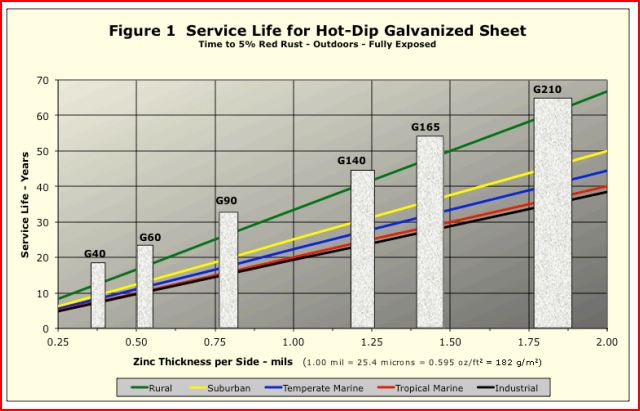
It can be seen in the picture. The greater the weight of the zinc coating, the longer the service life.
A G60 coating weight will exhibit approximately twice the life of a G30 coating weight.
A G90 coating weight will exhibit about 50% longer life than a G60 coating weight.
resource: https://www.galvinfo.com/wp-content/uploads/sites/8/2017/05/GalvInfoNote_1_6.pdf
Galvanized Coil vs. Galvannealed
Galvanized steel coil and galvannealed steel coil are two types of steel that have been coated with zinc to provide protection against corrosion. However, there are some key differences between these two types of steel:
Coating process: Galvanized steel coil is coated with a layer of zinc by immersing the steel coil in a bath of molten zinc. Galvannealed steel coil, on the other hand, is first coated with a layer of zinc and then subjected to a heat treatment process that alloyed the zinc and the steel, resulting in a zinc-iron alloy coating.
Coating appearance: Galvanized steel coil has a shiny, spangled appearance, while galvannealed steel coil has a matte gray finish.
Weldability: Galvanized steel coil is easier to weld than galvannealed steel coil, because the zinc coating on galvanized steel melts at a lower temperature than the zinc-iron alloy coating on galvannealed steel.
Paint adhesion: Galvannealed steel coil has better paint adhesion than galvanized steel coil, because the matte surface of galvannealed steel provides a better surface for paint to adhere to.
Hot-Dip Galvanized Steel Sheet Spangle
Spangles on galvanized steel sheets come in different sizes and shapes. The sparkles look like snowflakes or stars that glitter when there is light reflection. Producers of hot-dip galvanized steel have developed technology to reduce the size of spangles as customers prefer smooth and lead-free coatings.
Here are the different sizes of spangles.
- Regular spangle: This is a visible spangle that develops when the molten zinc that clings to the steel cools uncontrollably below the zinc’s melting point. It results in multifaceted zinc crystals.
- Minimized spangle: The spangle looks visible, yet it contains smaller and fewer patterns compared to the regular spangle. The development of zinc crystal growth is inhibited using a special production technique or a combined technique of molten zinc bathing and cooling.
- Spangle-free: The galvanized sheet is smooth with the absence of surface irregularities. The uniform finish is a product of coating batch chemistry, cooling technique, or a combination of both.
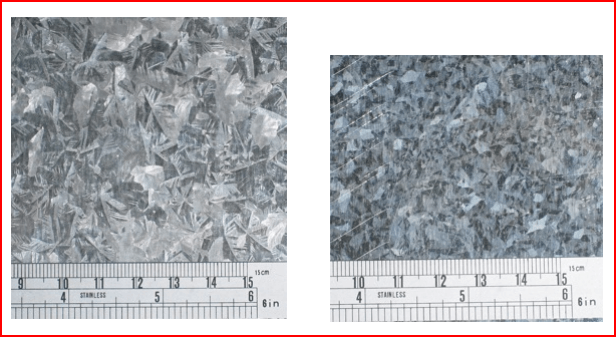
Figure A shows large spangles≥ 15 mm across and Figure B shows medium spangles up to 10 mm across
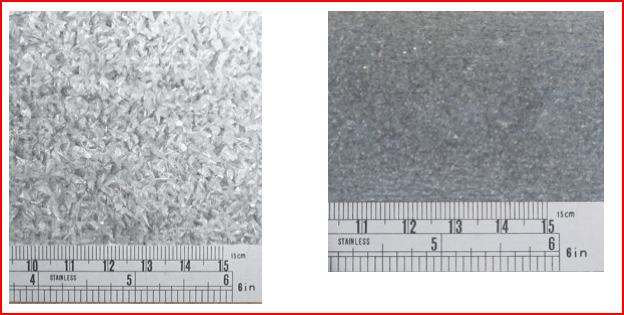
Figure C has small spangles up to 5 mm across, Figure D is spangle-free ≤ 0.5 mm across.
resource: https://www.galvinfo.com/wp-content/uploads/sites/8/2017/05/GalvInfoNote_2_6.pdf
Buyer’s Guide
Material Grade
When purchasing galvanized steel coils, the appropriate material grade should be selected according to the application. For roofing applications, the DX51D material of the en 10346 standard (equivalent to the Commercial steel of the ASTM A653 standard) should be selected. The light steel frame application will choose the astm a653 standard structural steel material, but it is necessary to purchase a suitable yield strength.
Coating Mass
The coating mass of the en 10346 standard is usually Z100, Z140, Z200, Z225, and Z275, which means both surfaces grams per square meter under the triple spot test method.
The coating mass of the ASTM A653 standard is commonly G30, G40, G60, and G90, which means both sides oz/square foot under the triple spot test method.
Tip: G90 = Z275
In the highly corrosive environment such as the seaside, you should choose the Z275 weight, and its price is relatively high.
Surface treatment
The purchase of galvanized coils should indicate the surface treatment, including Chemical passivation, Oiling, Phosphating, which play a role in preventing corrosion during transportation.
Conclusion
Choosing galvanized steel coil for outdoor application is a good decision. The product life depends on the thickness of the coating and the steel sheet.